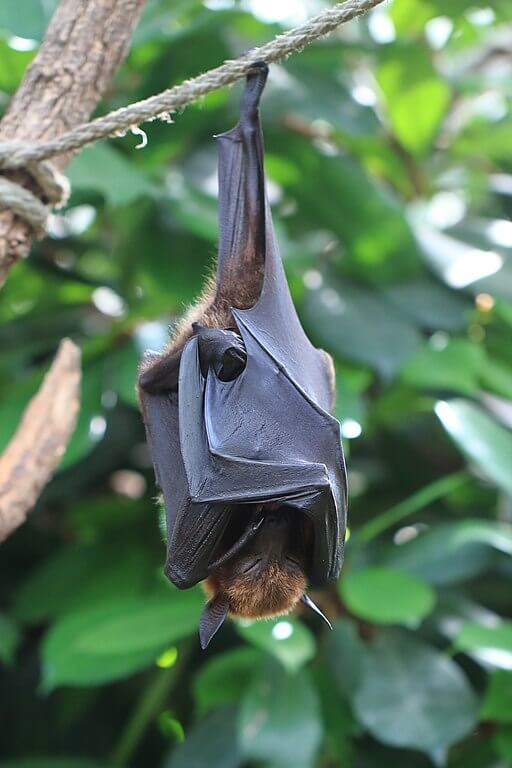Bat Moms Do A Lot Of Hanging About
by Laura Jenkins
Broadcast 8.4 & 8.7.2020

Photo by NobbiP, CC 3.0.
Listen:
Bats are wonderful, mysterious creatures: they swoop gracefully through the night, and sometimes through our nightmares. We fear what we don’t understand, and most of us know little about bats. They behave in strange ways: only breeding when it’s rainy, giving birth upside down, and sharing as a group the responsibility of nursing young.
However, these seemingly unusual activities make them very interesting creatures as well.
“Only breeding when it rains?” you might ask. Yes, it’s true. Female bats come into estrus only during the wet season, whether it’s January or February in the Southern Hemisphere or March or April in the Northern. Female bats are divided into territorial groups called harems, controlled by a single male bat. The harem leader fathers only about a third of the young in his harem, as females will often mate with leaders of other harems. However, it’s very unlikely that they will mate with a non-harem male. Males attract females by doing hovering displays in the air. For this reason, the reproductive success of males actually increases with decreasing size. Smaller males are more successful fathers because they can maneuver more nimbly in the air. Not only can they hover well and display themselves to females, they can maneuver well during actual mating, which happens – you guessed it – upside down.
Though humans often strive to make things more difficult than they really ought to be, one thing a human would not be interested in doing upside down is giving birth. Like many mammals, the female bats have only one baby per pregnancy. After three months of gestation, a baby bat emerges while the mother bat hangs upside down by her feet and sometimes with her thumbs grasping onto the ceiling or a branch as well. This is because bats’ feet are at rest when they are clasped around a support, and actually require muscles and energy to unclasp them. The baby bat comes out naked, feet-first, and sometimes grips his feet on his mother’s fur to help pull himself out. His mother holds him in her wings so he won’t fall below. Holding a baby while hanging upside down might seem pretty tiring. But what about nursing and caring for the young, day in, day out, upside down?
Female bats do not shirk their responsibility of hunting while they are taking care of a baby. Females often carry their young around the cave while hunting or leave them in little groups called creches. Females usually nurse their own young until two weeks before they are weaned, when they will allow other females to nurse their young as well. Though a study showed that statistically this is not likely to occur by accident, why this sharing happens is still up for debate. Curiously, female young are favored by other mothers, resulting in higher mortality in young males.
It seems to me the more we learn about bats, about how they mate and give birth and share the care of their young, the more questions seem to arise. The next time you watch a bat swooping through the night, don’t fear it entangling itself in your hair. Think of all the interesting things there are to learn about them, and be glad you don’t have to give birth upside down.
Every week since 1991, Field Notes has inquired about Montana’s natural history. Field Notes are written by naturalists, students, and listeners about the puzzle-tree bark, eagle talons, woolly aphids, and giant puffballs of Western, Central and Southwestern Montana and aired weekly on Montana Public Radio.
Click here to read and listen to more Field Notes. Field Notes is available as a podcast! Subscribe on iTunes, Google Play, or wherever you listen to podcasts.
Interested in writing a Field Note? Contact Allison De Jong, Field Notes editor, at adejong [at] montananaturalist [dot] org or 406.327.0405.
Want to learn more about our programs as well as fun natural history facts and seasonal phenology? Sign up for our e-newsletter! You can also become a member and get discounts on our programs as well as free reciprocal admission to 300+ science centers in North America!












